
Fordon, is a district in Bydgoszcz, Kuyavian-Pomeranian Voivodeship, Poland with a number of residents around 75,000. However, at the beginning, the district had only 8,000 residents. Currently, Fordon is the biggest district of Bydgoszcz.

Fordon, is a district in Bydgoszcz, Kuyavian-Pomeranian Voivodeship, Poland with a number of residents around 75,000. However, at the beginning, the district had only 8,000 residents. Currently, Fordon is the biggest district of Bydgoszcz.
Fordon is subdivided into 16 house estates:
- Stary Fordon - Akademickie - Bajka - Bohaterów - Eskulapa - Kasztelanka - Łoskoń - Mariampol - Nad Wisłą - Niepodległości - Pałcz - Powiśle - Przylesie - Szybowników - Tatrzańskie - Zofin
A settlement in place of Fordon is mentioned in sources for the first time in 1112 as Wyszogród . In those times there was located an important defensive castle which was eventually fired and destroyed in 1330 by the Teutonic Knights.
At some point, Fordon belonged to the Grand Duchy of Posen and later under direct Prussian control. It was returned to Poland at the end of the First World War. In 1939 it was incorporated by the Nazi Germany. It is estimated that during World War II German soldiers killed from 1200 to 3000 people, mainly Poles and Jews, in the Death Valley of Fordon (Valley of Death (Bydgoszcz)). The exact number stays unknown as historians have not found appropriate documents that would state the final number of deaths. In 1945 Fordon was liberated from Nazi occupation.
In 1950 Fordon was still a separate town from Bydgoszcz. At that time it was described as "seven miles east" of the latter city. It had a population of 3,514 people and manufactured such things as cement and paper. [1] In 1973 Fordon became a part of the city of Bydgoszcz.
The prison in Fordon was established in 1780 and changed into a men's/women's prison several times. From 1939-1956 among others, there were kept and killed 180 Ukrainian women in the prison. A memorial plaque was placed on the prison on May 10, 1992.[ citation needed ]

Universities
High Schools
Junior High Schools
Primary Schools
"Kujawsko-pomorskie dla każdego. Przewodnik turystyczny po najciekawszych miejscach województwa" Włodzimierz Bykowski, Wieńczysław Bykowski, wyd. Apeiron ISBN 83-919091-1-5 & Towarzystwo Przyjaciół Dolnej Wisły ISBN 83-919299-5-7, Bydgoszcz 2005
My Odyssey "Моя Одисея" Irena Tymoszko-Kaminska, Chicago 2005 page 286, ISBN 83-86112-21-2, Oficyna Wydawnicza UKAR 02-588 Warszawa 48, skr.poczt.156

Zamość is a historical city in southeastern Poland. It is situated in the southern part of Lublin Voivodeship, about 90 km (56 mi) from Lublin, 247 km (153 mi) from Warsaw. In 2021, the population of Zamość was 62,021.

Pruszcz Gdański is a town in Pomerania, northern Poland with 26,834 inhabitants (2010). Pruszcz Gdański is an industrial town neighbouring Gdańsk, part of the Tricity agglomeration. The Tricity Bypass begins in Pruszcz Gdański.

Żyrardów is a town and former industrial hub in central Poland with approximately 41,400 inhabitants (2006). It is the capital of Żyrardów County situated in the Masovian Voivodeship ; previously, it was in Skierniewice Voivodeship (1975–1998) 45 kilometres west of Warsaw. Żyrardów, initially a textile settlement, was named after French engineer and inventor Philippe de Girard, who worked in the area.
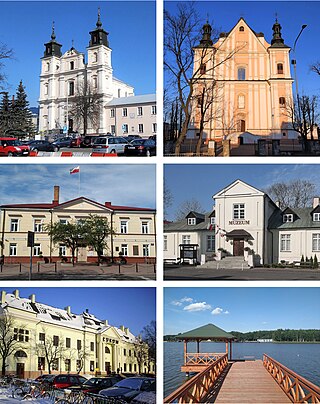
Łuków is a city in eastern Poland with 30,727 inhabitants. Since 1999, it has been situated in the Lublin Voivodeship, previously it had belonged to the Siedlce Voivodeship. It is the capital of Łuków County.

Mielec is the largest city and seat of Mielec County. Mielec is located in south-eastern Poland, in the Subcarpathian Voivodeship. The population of Mielec in December 2021 was 59,509.

Prudnik is a town in southern Poland, located in the southern part of Opole Voivodeship near the border with the Czech Republic. It is the administrative seat of Prudnik County and Gmina Prudnik. Its population numbers 21,368 inhabitants (2016). Since 2015, Prudnik is a member of the Cittaslow International.
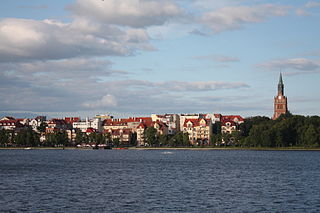
Ełk, also seen absent Polish diacritics as Elk, is a city in northeastern Poland with 61,677 inhabitants as of December 2021. It is the seat of Ełk County in Warmian-Masurian Voivodeship. It lies on the shore of Ełk Lake, which was formed by a glacier, and is surrounded by extensive forests. It is the largest city and unofficial capital of historical Masuria. One of the principal attractions in the area is legal hunting.

Giżycko is a town in northeastern Poland with 28,597 inhabitants as of December 2021. It is situated between Lake Kisajno and Lake Niegocin in the region of Masuria, and has been within the Warmian-Masurian Voivodeship since 1999, having previously been in the Suwałki Voivodeship (1975–1998). It is the seat of Giżycko County.

Leszno is a historic city in western Poland, within the Greater Poland Voivodeship. It is the seventh-largest city in the province with an estimated population of 62,200, as of 2021. Previously, it was the capital of the Leszno Voivodeship (1975–1998) and is now the seat of Leszno County.
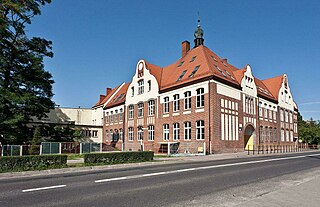
Sulęcin is a town in western Poland with 10,117 inhabitants (2019), the capital of Sulecin County, since 1999 in Lubusz Voivodeship.

Education in Poland is compulsory; every child must receive education from when they are 6 years old until they are 18 years old. It is also mandatory for 6-year-old children to receive one year of kindergarten education, before starting primary school at 6 years old. Primary school lasts eight years, and students must take a final exam at the end of the eighth grade. After graduating from primary school, people typically go on to attend secondary school, which lasts 4 or 5 years. They can also choose to educate themselves towards a specific profession or trade, and receive work experience and qualifications through apprenticeships. After graduating from secondary school and passing the final exam, called the matura, one can pursue a higher education at a university, college, etc.
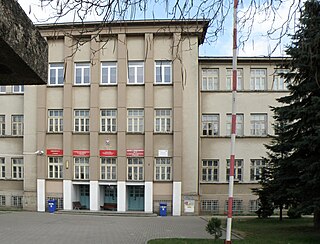
John Paul II High School in Tarnów is a general education liceum in Tarnów, Poland. The school was established in 1945.
Zespół Szkół Ogólnokształcących nr 10 – public school consisting of I Liceum Ogólnokształcące im. Edwarda Dembowskiego and Gimnazjum nr 14, located on Zimnej Wody street in Gliwice, Poland.

Cyprian Kamil Norwid High School Nr.1 in Bydgoszcz is a Polish general education liceum in Bydgoszcz, one of the oldest high schools in northern Poland, founded in 1619, located at 9 Freedom Square.

The Copernicanum is a historical building in downtown Bydgoszcz, which had been designed as a scholar building: initially a realschule, it then took the purpose of a city sciences high school and technical railway institutions. Registered on the Kuyavian-Pomeranian Voivodeship Heritage List, it is nowadays the location of a junior high school.

The main building of Bydgoszcz Music Academy is a historical edifice in downtown Bydgoszcz, dating back to the early 20th century. It is registered on the Kuyavian-Pomeranian Voivodeship Heritage List.
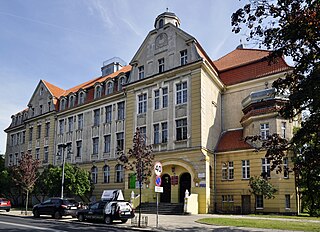
High School Nr.6 is a Polish high school in Bydgoszcz, located at Staszica Street 4. The institution is in the vicinity of Ignacy Jan Paderewski Pomeranian Philharmonic building, Bydgoszcz Music Academy - "Feliks Nowowiejski" and the Bydgoszcz Music Schools. No far from High School Nr.6 stand St. Vincent de Paul Basilica and Cyprian Norwid High School Nr.1. The building is registered on the Kuyavian-Pomeranian Voivodeship Heritage List.

Dąbrówka High School in Poznań is a public school, located in the Poznań district of Jeżyce; it offers education to teenagers above 15 years of age. Founded in 1919, until 1967 it operated as an establishment for girls only. Currently its somewhat distinctive profile is marked by bilingual, Polish-German curriculum, complete with the Deutsches Sprachdiplom II exams. In terms of educational performance the school ranks among mid-range college-type schools in Poznań.